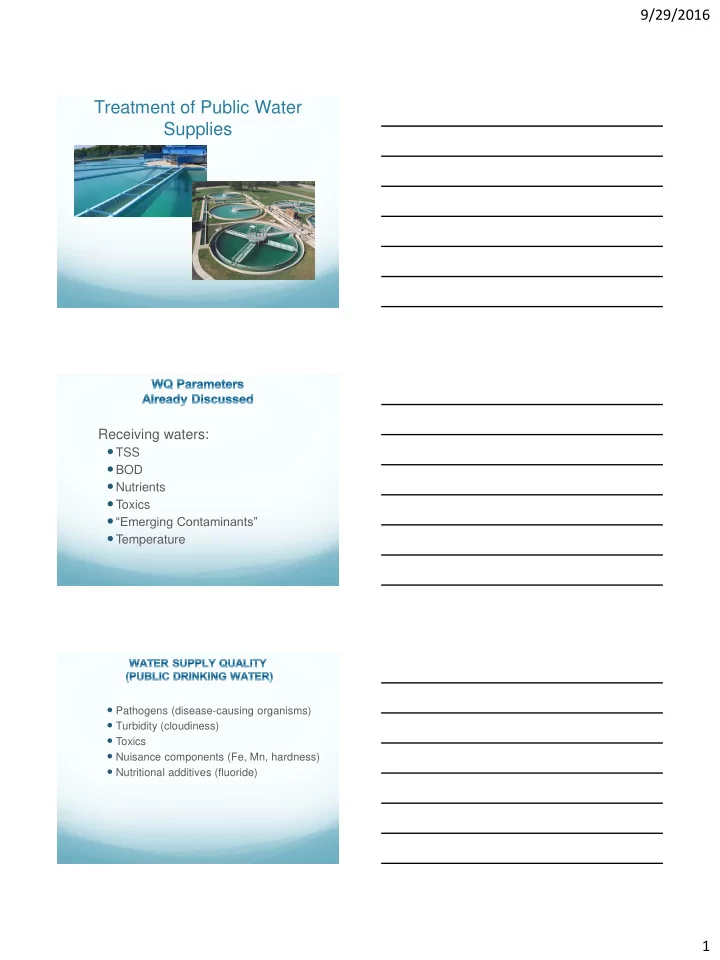

9/29/2016 Treatment of Public Water Supplies Receiving waters: TSS BOD Nutrients Toxics “Emerging Contaminants” Temperature Pathogens (disease-causing organisms) Turbidity (cloudiness) Toxics Nuisance components (Fe, Mn, hardness) Nutritional additives (fluoride) 1
9/29/2016 Three Lectures: Today: Overview of historical and contemporary supply and treatment infrastructure. Wednesday: Focus on legal requirements for pathogen removal in public water supplies; disnfection methodologies. Next Monday: Engineered solutions to meet federal and state public health standards London, 1850s Much of the developing world today London 2
9/29/2016 Tokyo World’s Largest: Jardine WTP Chicago Jardine WTP ~ 1 billion gal/day 3
9/29/2016 5 Million Customers Lake Michigan Intake Carter-Harrison and Dever Intake Cribs 4
9/29/2016 Inside The Carter-Harrison Crib 7-hour Treatment Process 5
9/29/2016 A Quick 5000-year Look at Water Supply and Treatment Nippur, Sumeria 5000 Yrs BP Wells Supply culverts Cisterns Wastewater drains India 4000 yrs BP Water purification described in Sanskrit Texts Boiling in copper vessels Exposure to sunlight Filtering through charcoal 6
9/29/2016 Roman Aqueducts Still in Use! Venice, 5 th -16 th c.: Rainwater/Well/Filters Well in Campo S. Maria Formosa Venetian Plaza Filtration Well 7
9/29/2016 Municipal Filtered Water 1804 Paisley, Scotland Via wagon tanks 1807 Glasgow, Scotland Piped in 1850s UK, France Modern rapid sand filters Henry Darcy and the fountains of Dijon Dr. John Snow Cholera Epidemic London, 1854 The Modern Era: 20 th -21 st c. Chemical disinfection Chlorination Maidstone, England 1897 Jersey City, NJ, 1908 Ozonation Advanced filtration systems Ultraviolet light (UV) disinfection 8
9/29/2016 Safe Drinking Water Act (SDWA, 1974) Defines a public water system (PWS) as one that serves piped water to at least 25 persons or 15 service connections for at least 60 days each year. There are approximately 161,000 public water systems in the US. ~270,000,000 users. Such systems may be publicly or privately owned. Pathogens in Water Viruses Poliovirus, viral gastroenteritis, hepatitis A Bacteria E. coli, Vibrio cholerae, Shigella spp. Protozoans Entamoeba histolytica Giardia lamblia Cryptosporidium parvum Oocysts: Cryptosporidium Outbreaks Year Location Reported Cases Reported Deaths 1984 Braun Station, TX 2,000 1987 Carrollton, GA 13,000 1989 Thames River area, UK 100,000 1992 Jackson County, Oregon 15,000 1993 Milwaukee, Wisconsin 403,000 100 1994 Las Vegas, NV 78 16 9
9/29/2016 Chlorine Residual A powerful safety measure to have disinfecting capability in the system Dateline News: Pineville, LA. Flavored water?? But residual chlorine does not ALWAYS work 10
9/29/2016 CDC Warns Of Swimming Pool Parasite Cryptosporidium Cryptosporidium can survive for 10 days or more in chlorine-treated water Dateline: Portland, OR Parasite in Pool Infects 51 People at Summer Party An outbreak of cryptosporidiosis in Sellwood continues to affect a number of children and adults Oregonian Friday, September 25, 1998 11
9/29/2016 Highlights of the SDWA Authorizes EPA to set enforceable health standards for contaminants MCL = Maximum contaminant level MCLG = Maximum contaminant level GOAL TT = Specified Treatment Technology Examples of Pathogen Regs Coliforms: MCLG = 0 MCL = <5% “+” tests/month for total coliforms Advanced test for fecal coliforms = 0 Giardia & Cryptosporidium: MCLG = 0 TT: Filtration or UV to achieve log-3 removal (99.9%) Other Highlights of the SDWA Requires public notification of water system violations & annual reports to consumers Establishes federal-state partnership for regulation, enforcement 12
9/29/2016 Highlights of the SDWA Provisions specifically designed to protect underground sources of drinking water Requires disinfection and filtration of surface water supplies… Except those with pristine, protected sources (hello Portland) Establishes a multi-billion-dollar state revolving loan fund for water system upgrades Bottom Line for US Designers Must chlorinate water Must reduce pathogens by 99.9% (“ log-3 removal”) For surface water sources m ust have technology to remove or destroy certain protozoa pathogens. Typically means filtration. UV is the alternative (e.g., Seattle) -- OR — Must have a specially protected supply watershed Post-treatment storage reservoirs must be covered Water Samples: Test for E. Coli System with Unfiltered Filtration System Low High Crypto coliforms coliforms analysis Basic Low Crypto High Crypto disinfection (chlorination count count only) Design/imple ment additional treatment 13
Recommend
More recommend